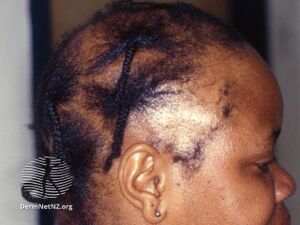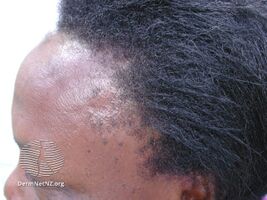Traction alopecia
| Traction alopecia | |
|---|---|
 | |
| Specialty | Dermatology |
| Frequency | Lua error in Module:PrevalenceData at line 5: attempt to index field 'wikibase' (a nil value). |
Traction alopecia is a type of hair loss caused by pulling force being applied to the hair.[1]
This commonly results from the sufferer frequently wearing their hair in a particularly tight ponytail, pigtails, or braids. It is also seen occasionally in long-haired people who use barrettes to keep hair out of their faces. Traction alopecia is recession of the hairline due to chronic traction, or hair pulling, and is characterized by a fringe along the marginal hairline on physical exam.[2][3] Even though this "fringe sign" is considered a useful clinical marker of this condition, cases of frontal fibrosing alopecia presenting with an unusual retention of the hairline (pseudo-fringe sign) have been described.[4]
Cause
It is commonly seen with certain hair styles or braiding patterns that pull the hairline forcefully towards the vertex of the scalp,[5][6] and has been reported more often in African American women (as some wear their hair tightly pulled back), in whom it can cause scarring.[7][8] It has also been seen in female ballerinas,[9] and in cultural traditions where the hair is voluntarily not cut in religious obeisance, the latter caused by progressively increasing weight of the hair itself.[citation needed] Traction alopecia is mechanical in cause, rather than androgenic, and treatment is typically not pharmaceutical. Management includes cessation of the chronic traction, cosmeses, with surgical restoration reserved for more severe cases.[8]
Traction alopecia is a substantial risk in hair weaves, which can be worn either to conceal hair loss, or purely for cosmetic purposes. The former involves creating a braid around the head below the existing hairline, to which an extended-wear hairpiece, or wig, is attached. Since the hair of the braid is still growing, it requires frequent maintenance, which involves the hairpiece being removed, the natural hair braided again, and the piece snugly reattached. The tight braiding and snug hairpiece cause tension on the hair that is already at risk for falling out. Traction Alopecia is one of the most common causes of hair loss in African American women. Sikh men are also susceptible to traction alopecia if the hair under the turban is tied too tightly for many years.[10]
Other causes include:
- Hairstyle. Although the aforementioned style is one of the culprits, hairstyles such as dreadlocks and single (extension) braids can also have the same effect. Men and women who have suffered from traction alopecia have found that the hair loss occurs most at the hair line—primarily around the temples and the sides of their heads.
- Headgear. Compressive safety helmets worn tightly and closely to the scalp are a cause of traction alopecia. The lining of tightly fitted safety helmets like those worn for activities such as motorcycling, cycling, skiing and snowboarding are responsible for the constant rubbing and tugging of localised areas of the hair and scalp. Frequent wearers or those who use such helmets for prolonged periods seem more likely to suffer traction alopecia.[citation needed]
- Chemicals. A condition known as CCCA (central cicatricial centrifugal alopecia), seen almost exclusively in African American women, can cause extensive hair loss. It is caused by a combination of too much stress (traction) on the hair and the use of harsh relaxers and dyes.
Additional images
-
Traction alopecia
-
Traction alopecia
See also
References
- ↑ Onalaja, Amanda A.; Taylor, Susan C. (2021). "1. Defining skin color". In Li, Becky S.; Maibach, Howard I. (eds.). Ethnic Skin and Hair and Other Cultural Considerations. Switzerland: Springer. p. 14. ISBN 978-3-030-64829-9. Archived from the original on 2022-09-04. Retrieved 2022-08-29.
- ↑ Khumalo, N. P. (2012). "The "fringe sign" for public education on traction alopecia". Dermatology Online Journal. 18 (9): 16. PMID 23031383.
- ↑ Samrao, A.; Price, V. H.; Zedek, D.; Mirmirani, P. (2011). "The "Fringe Sign" - A useful clinical finding in traction alopecia of the marginal hair line". Dermatology Online Journal. 17 (11): 1. PMID 22136857.
- ↑ Pirmez, R.; Duque-Estrada, B.; Abraham, L.S.; Pinto, G.M.; de Farias, D.C.; Kelly, Y.; Doche, I. (July 2015). "It's not all traction: the "Pseudo-fringe sign" in frontal fibrosing alopecia". British Journal of Dermatology. 173 (5): 1336–1338. doi:10.1111/bjd.14005. PMID 26138941.
- ↑ Ahdout, J.; Mirmirani, P. (2012). "Weft hair extensions causing a distinctive horseshoe pattern of traction alopecia". Journal of the American Academy of Dermatology. 67 (6): e294–e295. doi:10.1016/j.jaad.2012.07.020. PMID 23158648.
- ↑ Urbina, F.; Sudy, E.; Barrios, M. (2009). "Traction folliculitis: 6 cases caused by different types of hairstyle that pull on the hair". Actas Dermo-sifiliograficas. 100 (6): 503–506. doi:10.1016/s1578-2190(09)70108-8. PMID 19709556.
- ↑ Borovicka, J. H.; Thomas, L.; Prince, C.; Mehregan, D. R. (2009). "Scarring alopecia: Clinical and pathologic study of 54 African-American women". International Journal of Dermatology. 48 (8): 840–845. doi:10.1111/j.1365-4632.2009.04129.x. PMID 19659862.
- ↑ 8.0 8.1 Fu, J. M.; Price, V. H. (2009). "Approach to Hair Loss in Women of Color". Seminars in Cutaneous Medicine and Surgery. 28 (2): 109–114. doi:10.1016/j.sder.2009.04.004. PMID 19608062.
- ↑ Lillis, J. V.; Guo, C. S.; Lee, J. J.; Blauvelt, A. (2010). "Traction Alopecia in a Ballerina: Clinicopathologic Features". Archives of Dermatology. 146 (8): 918–919. doi:10.1001/archdermatol.2010.183. PMID 20713841.
- ↑ Karimian-Teherani, D.; El Shabrawi-Caelen, L.; Tanew, A. (2011). "Traction Alopecia in Two Adolescent Sikh Brothers-An Underrecognized Problem Unmasked by Migration". Pediatric Dermatology. 28 (3): 336–338. doi:10.1111/j.1525-1470.2011.01241.x. PMID 21371118.
External links
- Causes of Hairloss Archived 2021-01-12 at the Wayback Machine
| Classification | |
|---|---|
| External resources |

